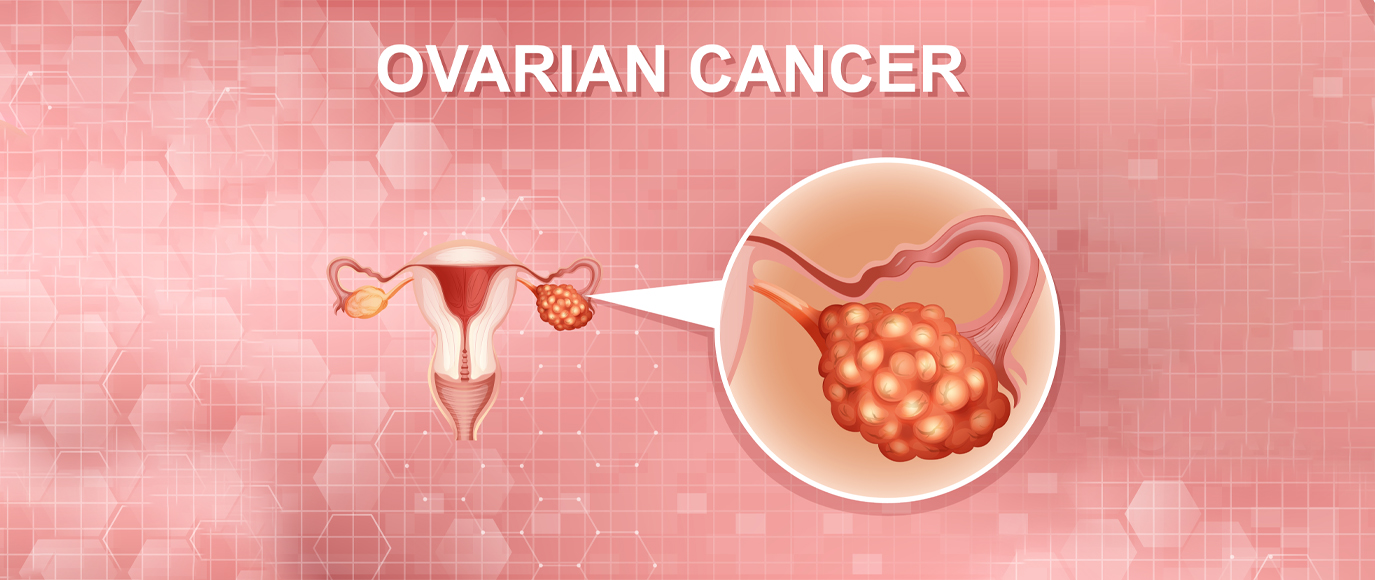Introduction:
Ovarian cancer is the 8th most commonly occurring cancer in women across the world.It is a deadly disease, though a silent killer, since it is not known to show any early signs and symptoms. Patients may initially have subtle and non-specific symptoms, making it a challenge to detect until it reaches a very advanced stage. This in turn makes treatment complex, often increasing the chances of morbidity and mortality.
According to Globocan’s 2020 projections, by 2040, the number of women around the world diagnosed with ovarian cancer will rise almost 42%. The number of women dying from ovarian cancer each year is projected to increase to 313,617 an increase of over 50% from 2020.
How does Ovarian Cancer originate?
Ovarian cancer is a malignant cell growth that begins in the ovaries, the organs that produce eggs in females. It often occurs unilaterally or on both sides and spreads quickly to nearby organs through direct extension, to abdominal organs through a process known as abdominal seeding and to distant organs through the blood and lymphatic systems. While exact causes are still unknown, genetic mutation in BRCA1 and BRAC2 genes are said have links with the disease.Initially individuals with ovarian cancer can be asymptomatic and have minimal and vague symptoms.
How to Identify risk factors of ovarian cancer?
As mentioned earlier, doctors haven’t been able to pinpoint specific causes to diagnose ovarian cancer, however certain risk factors have helped identify early signs. These include:
- Genetic Factors: Women with a family history of ovarian cancer or breast cancer and genetic mutation in BRAC1 & BRAC2 genes are at a higher risk of developing the disease.
- Age: The disease is known to have higher incidence in postmenopausal women especially those over the age of 60.
- Hormonal Factors: Early onset of menstruation, late menopause and never having given birth, can increase the chances of ovarian cancer in women.
- Endometriosis: Women diagnosed with endometriosis, a condition where tissue similar to the lining of the uterus grows outside the uterus, can be at a higher risk of ovarian cancer.
- Obesity: Women carrying excessive weight or being obese are considered to be at a higher risk of ovarian cancer. People with a BMI over 30 are more likely to develop ovarian cancer.
- Reproductive History: Females having their first child after the age of 35 or those who have never given birth are at an increased risk of ovarian cancer.
- Therapy: Postmenopausal women on Hormone replacement therapy (HRT), premenopausal women undergoing ovarian stimulation for fertility are at a slightly increased risk of ovarian cancer.
What are the Indications of ovarian cancer?
While screening for certain cancers such as breast and cervical cancers are quite straightforward, ovarian cancer is quite tricky due to the lack of highly effective screening tests. However, the most effective indications to look out for are listed below:
- Persistent Symptoms: Women experiencing persistent abdominal pain, bloating, unexplained weight loss, changes in bowel and urinary habits should consult a medical professional.
- Genetic Predisposition: Females with a known genetic predisposition to certain cancers such as breast and ovarian cancers should regularly undergo screening.
- Family History: Women with a strong family history of ovarian cancer or known BRCA mutations must discuss available screening options with their healthcare provider.
What are the signs & symptoms of Ovarian Cancer?
Early diagnosis is crucial to ensure better treatment outcomes, hence it is important to identify symptoms that exist and seek treatment at the earliest. Following are few of the signs and symptoms to look out for:
- Abdominal Pain: Pain in the abdomen lasting for over 2 weeks, persistent discomfort in the pelvic or lower abdominal area.
- Back Pain: Sudden, unexplained lower back pain.
- Bloating: Feeling of fullness or bloating often accompanied by gas or indigestion.
- Change in Bowel and Urinary Habits: Changes in bowel movements leading to constipation or diarrhea, Increased urgency and frequency in urination.
- Change in Appetite: Loss of Appetite or feeling full immediately after eating small portions of food.
- Change in Menstrual Cycle: Postmenopausal bleeding or irregular menstrual cycles including heavy bleeding.
- Fatigue: Feeling tired or fatigue in spite of sufficient rest.
- Weight Loss: A drastic and sudden drop in weight in spite of no changes in diet and physical activity.
- Pain during Sexual Intercourse.
It is important to note that having these symptoms doesn’t necessarily mean an individual has ovarian cancer. These symptoms can be caused by various other conditions as well. However, if symptoms persist for a long time and are unusual for an individual, it is essential to seek medical help and get tested.
How is Ovarian Cancer diagnosed and tested?
While research is ongoing, there isn’t a foolproof ovarian cancer screening test. This in turn creates challenges in diagnosing the disease in the early stages. The pathway to diagnosis includes the following tests:
Imagining Tests:
- Pelvic Examination / Transvaginal Pelvic Ultrasound
- MRI
- CT Scan
- PET Scan
Blood Tests:
Blood tests are done to identify a substance called CA -125. Higher levels of CA 125 generally indicate the presence of cancer. However, this isn’t conclusive, meaning individuals with cancer may have lower levels of CA -125, while higher levels may not necessarily mean one has cancer.
For this reason, blood tests are combined with other tests to come to a conclusion.
Surgery:
Doctors may diagnose ovarian cancer during surgery if they find abnormal growth and may remove it during the procedure.
Laparoscopic Surgery:
A surgeon uses a camera (laparoscope) as a guide via a small cut in the abdomen to assess the cancer, perform a biopsy to evaluate the extent of the disease and if need be, remove ovarian tumours.
What are the stages of Ovarian Cancer?
There are 4 stages of ovarian cancer:
Stage I: can be divided into 3 substages:
- Substage a: Here the cancer is confined to 1 ovary or 1 fallopian tube
- Substage b: Cancer has spread in both ovaries or fallopian tubes
- Substage c: Cancer is found outside the ovary or in the peritoneal cavity.
Stage 2: Cancer has spread to the uterus and to other pelvic organs.
Stage 3: Cancer spreads to the abdomen or lymph nodes.
Stage 4: Metastasis, cancer spreads to distant organs, such as the liver, spleen, chest or lungs.
Staging is crucial, as it helps the doctor in personalizing the treatment plan.
What are the treatment options for Ovarian Cancer?
The goal of treatment is to remove as much, if not all cancer from the body. Advances in medical science has yielded several treatment modalities that can ensure an individual overcomes ovarian cancer with early detection. Some of the treatments for ovarian cancer include:
Chemotherapy: This form of treatment Is employed either before surgery or after a surgery.This involves use of drugs designed to target and kill the cancerous cells in the body. Provided intravenously (via a vein) or orally (via pills).
Surgery: Primarily used to remove the organ affected by cancer. Laparoscopy (minimally invasive surgery) or Laparotomy (open surgery via an abdominal incision) are 2 methods employed.
Before surgery, a patient is evaluated for physical wellbeing (performance status). If a patient is deemed fit physically, cytoreductive surgery (CRS), a surgical procedure that aims to reduce the amount of cancer cells, is performed to a reduce all visible tumours. This is followed by chemotherapy to complete the treatment.
In case of poor surgical candidates (low performance status), initial chemotherapy (neoadjuvant) is given to control the disease, improve the nutrition and physiotherapy making them fit for surgery and interval cytoreductive surgery is performed followed by chemotherapy to complete the treatment.
Hormonal Therapy: Few ovarian cancers use hormones to multiply. This form of treatment blocks hormones and preventing and nullifying further growth.
Radiation Therapy: This is one of the lesser used forms of treatment that attempts to destroy cancerous cells.
Targeted therapy: This form of treatment attempts to change the way cancer cells multiply and divide by means of drugs that identify and attack cancel cells.
What is Post-surgical surveillance?
- Post treatment, regular follow-ups for observation is mandatory. This is done to ensure the cancer doesn’t relapse over time. Any symptoms must be promptly discussed with your doctor, based on which a few imaging tests will be suggested.
- Patients need to be kept under surveillance every 3 months for first 2 years followed by every 6 months for next 3 yearly followed by annually thereafter.
- For Stage 4/metastatic, treatment will include palliative and supportive care.
- Relapse or recurrence chances are higher in advanced stage disease, which needs regular and strict surveillance to give best results.
- Newer advances like HIPEC AND PIPAC in the management of locally advanced diseases have improved the disease free interval and overall survival rates of the patient.
- Newer targeted therapy agents like PARP inhibitors eg., Olaparib is an oral medication very useful in treatment of recurrent ovarian cancers. Immunotherapy trials are ongoing in treatment of ovarian cancers.
Can ovarian cancer be Prevented?
While ovarian cancer cannot entirely be prevented, a few steps can help in reducing the risks:
- Regular Health Check-ups
- Knowing your family history
- A balanced diet consisting of fruits, vegetables and whole grains
- Regular physical activity
- Genetic Testing for High Risk Individuals
- In individuals having BRCA mutation, doctors may recommend removal of ovaries, fallopian tubes before they become cancerous.
During the screening, assessment, treatment, surveillance there is a lot of issues related to compliance of the patient either physically, mentally and financially, therefore social support plays a major role in the outcome of the treatment.
With the theme of “close the care gap” and the call to unite voices and take action, oncologists are working at the forefront to gain confidence of the patient, so the standard guidelines based treatment can be given to the patient.


















